
First and Only Weekly Online Fanzine Devoted to the Life and Works of Edgar Rice Burroughs Since 1996 ~ Over 15,000 Webpages and Webzines in Archive |

First and Only Weekly Online Fanzine Devoted to the Life and Works of Edgar Rice Burroughs Since 1996 ~ Over 15,000 Webpages and Webzines in Archive |


![]()
![]()
John Coleman Burroughs’
Illustrations for
Escape On Venus
Commentary by David Adams
![]()
![]()
This is the second and final book
illustrated by John Coleman Burroughs for his father’s Venus series.
John had a fine sense of creating
otherworldly creatures based upon the descriptions given in the text.
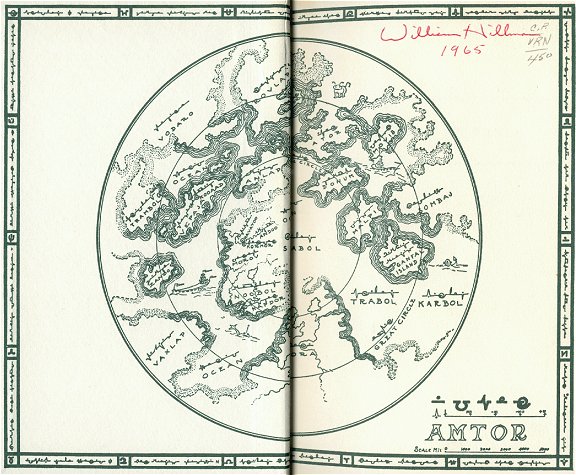
Cover interior and facing page:
ERB’s map of Amtor found in both front and back.
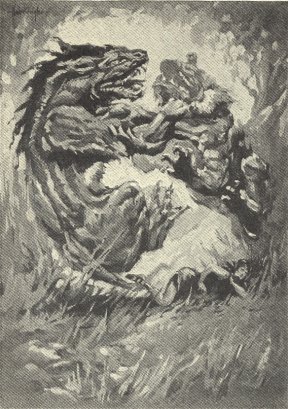 |
“The two creatures met above her” (Chapter 39) “The tharban might be described as the Amtorian lion, although it does not bear much resemblance to Felis leo except that it is a ferocious carnivore. It is much larger; its tawny coat is striped lengthwise with dark brown markings; its enormous jaws, splitting half the length of its head, are armed with sixteen or eighteen large fangs and its feet are equipped with three heavily taloned toes; it has a black mane, much like that of a horse, long, pointed ears, and the tail of a lion. It also has a most abominable disposition and an insatiable appetite” (242). The tongzan is “a creature as large and as terrible as the tharban.” ERB describes it thusly: “Its body closely resembled that of a Bengal tiger; in the center of its forehead was a single eye on a short antenna; from the shoulders, just anterior to the forelegs, grew two enormous chelae; and its jaws were as terribly armed as those of the tharban” (243). In a circular composition, a tharban and a tongzan fight over the tiny, fallen Duare. JCB has followed his father’s description of the beasts with precision. One wishes that this illustration had been presented in color to give greater force to his original conception. |
One might compare this illustration with those of Eric Howley in David Day’s “The Burroughs Bestiary,” whose tharban has a more flattened face like a mountain lion, and whose tongzan’s crab-like pincers are much better delineated.Frank Frazetta gives us a nice rendition of a colored tharban with its red and white stripes on the Ace edition of “Lost on Venus,” and another nice colored version of the beast is on “The Wizard of Venus” illustrated by Richard Hescox in the newer Del Rey edition.
Joe Jusko also painted a nice, stylish tongzan with a red mane for his card #94 and card #105, which shows J. Allen St. John’s eerie version on the flip side.
I like to think of these continuing lion-tiger distortions as a part of ERB’s joking over his” tiger in Africa” gaffe that occurred when he wrote Tarzan of the Apes. One of the broadest symbolic jokes in this series is when he fills England with hundreds and lions and tigers in “Beyond Thirty.”
ERB finally puts the lion-tiger problem to rest in “Beyond the Farthest Star” when he has Tangor rip a lion striped like a zebra to shreds with explosive bullets. R.I.P. No tigers allowed in Africa or anywhere else either.
See the art referred to here in our
THARBAN REFERENCE GALLERY
Interpretations by other artists
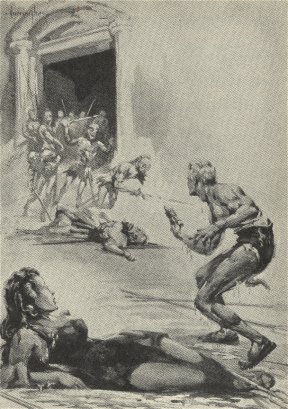 |
“The Warriors were no match for me” (Chapter 16) A full-bodied Duare lies in the foreground while Carson threatens a host of Myposan warriors with his pistol, who are pouring through a large, classically arched doorway. Many tridents already lie at his feet. The shading is so subtle that the effect is partially lost in the black and white version. The foreground figures of Duare and Carson are well defined while the Myposans come out of a blurred distance. |
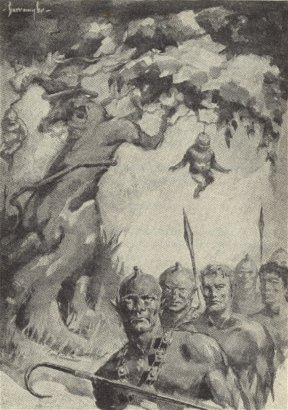 |
“Pretty nearly ripe and about to fall off” (Chapter 25) Among the Brokols, Carson finds that their children were born from trees like fruit, attached by stems attached to the tops of their heads. This knob was retained by adult Brokols. JCB pictures Carson and his friend, Jonda being lead by a group of warriors past a large tree upon which two babies are “nearly ripe.” The warriors of Brokol are “of a sickly greenish hue and entirely hairless -- no hair on their heads, no whiskers, no eyebrows, no eyelashes” (149). The warrior leading the pair carries
one of their nasty weapons,
|
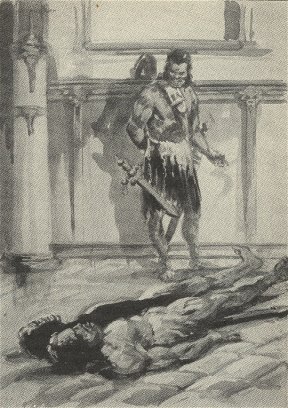 |
“The two halves rolled apart” In this seemingly grim scene a Vooyorgan is simply reproducing. “You see, these creatures are amoebic neuters; and their dividing is the physiological phenomenon of reproduction . . . they divide into two parts, like the amoeba and other of the Rhizopada” (206). A guard looks down upon the dividing Dan-voo-med, looking rather pleased at his accomplishment. He wears a short, Roman sword at his waist and a longer, barbarian sword on a thick, leather shoulder strap and the typical, single, South Sea islander’s skirt. |
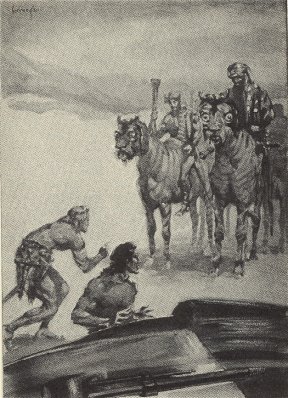 |
“Savage-looking men mounted upon zorats” (308) A group of Noobol warriors wearing
Arabic turbans sit astride
These zorats also have pendulous ears like large cocker spaniels. They have just startled Carson and Ero Shan, who were about to board their space vehicle in the foreground. Since zorats are not the large,
dramatic Burroughsian cats or other terrible beasts of his menagerie of
strange creatures they probably have not been rendered by artists very
much.
|
On a final note about these pictures for “Escape on Venus” I must remark upon the strangeness of the topics. Of course, Amtor is a strange world, and JCB did a great job of picturing the oddities there, however, it seems unfortunate to me that he did not find a way to create at least one picture of classical repose in this grouping, perhaps with Carson and Duare.I suppose that book illustrators need to be specific, and JCB does follow his father’s descriptions to the letter, yet at times I wish that he might have found a way to make a few of his paintings for this book more universal in appeal. I get the feeling that he was filling an order here rather than really being inspired by the topic of a man and a maid on a lush, tropical planet.
I don’t mean to belittle JCB’s accomplishments here at all. He is a great illustrator of ERB’s creatures, which may be argued to be his strong point as a Burroughs artist. I would just like to have seen that one great romantic picture of the two lovers which would have put the icing on the cake.
Nkima
April 30, 2000
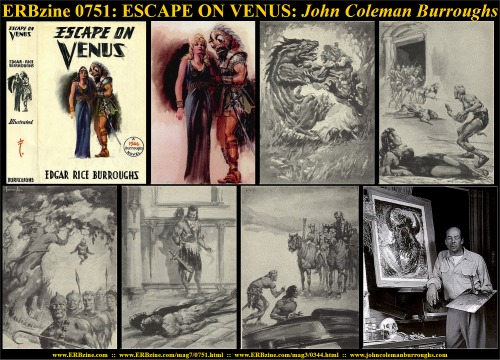
![]()
![]()
THARBAN
REFERENCE GALLERY
Interpretations by other artists
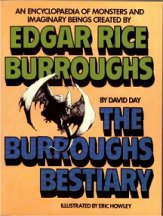
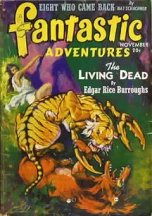
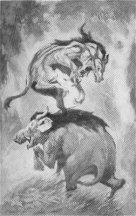
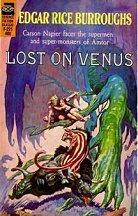
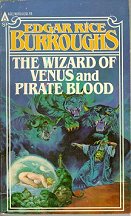
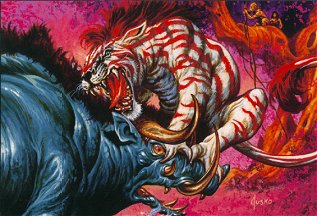
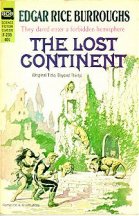
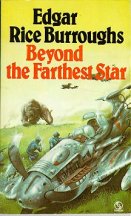
![]()

![]()
![]()
![]()
Volume
0344

BILL
HILLMAN
Visit
our thousands of other sites at:
BILL
and SUE-ON HILLMAN ECLECTIC STUDIO
ERB
Text, ERB Images and Tarzan® are ©Edgar Rice Burroughs, Inc.-
All Rights Reserved.
All
Original Work ©1996-2006/2018 by Bill Hillman and/or Contributing
Authors/Owners
No
part of this web site may be reproduced without permission from the respective
owners.